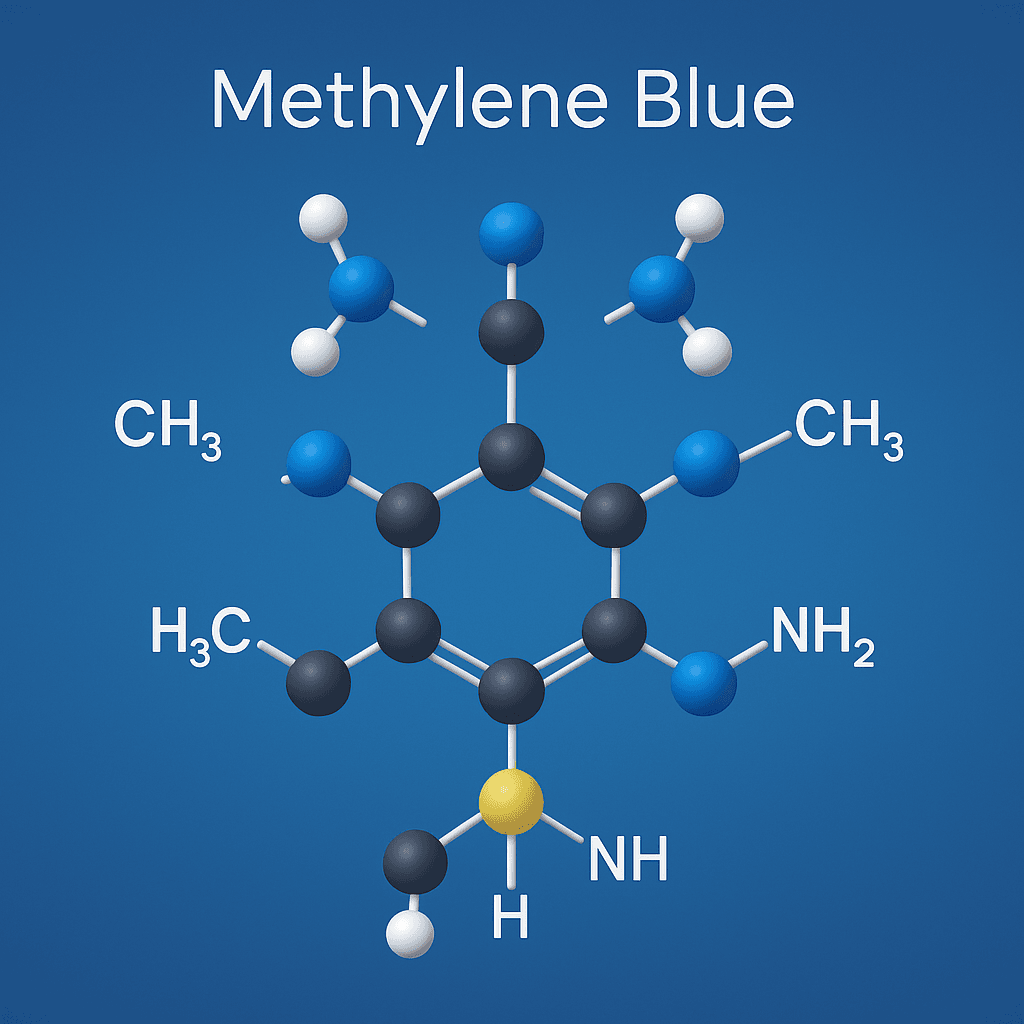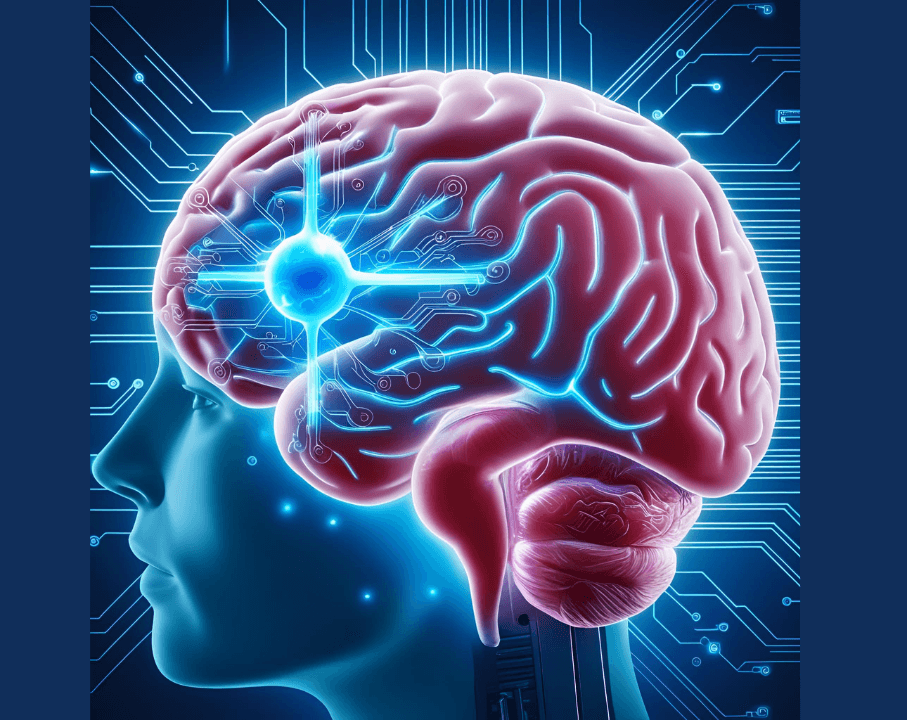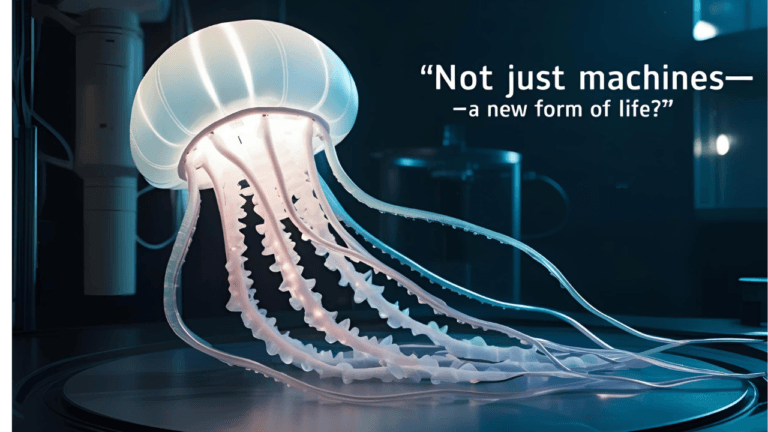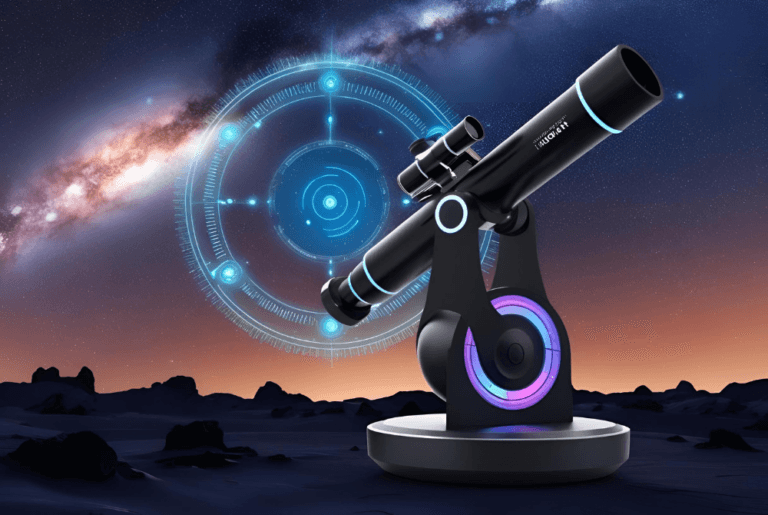Introduction: The Resurgence of Methylene Blue
What if one overlooked molecule—bright blue in color—could protect your neurons, enhance your memory, fight infections, and charge up your cells like a biological battery?
It might sound like a line from a futuristic sci-fi novel, but this isn’t a fantasy. That molecule exists, and it’s called methylene blue. First synthesized in 1876 as a textile dye, it soon proved too powerful to remain confined to fabric. Doctors in the early 20th century discovered it could treat malaria, acting as one of the very first synthetic antimicrobial drugs. Later, it became an emergency treatment for methemoglobinemia, a blood condition that impairs oxygen delivery. And that was just the beginning.
Today, methylene blue is gaining renewed attention in the scientific world, with researchers exploring its potential to impact neurodegenerative diseases, boost cognitive function, support longevity, and influence cellular energy systems. Unlike many synthetic drugs, it doesn’t just mask symptoms—it interacts directly with the mitochondria, the powerhouse of your cells, where it can boost energy output, reduce oxidative stress, and potentially slow down the biological aging process.

This humble dye is now being reexamined as a methylene blue neuroprotective agent in Alzheimer’s research, an off-label nootropic among life-extension enthusiasts, and even as part of experimental therapies involving brain-computer interfaces. Researchers are beginning to ask: could methylene blue be a key molecule for maintaining cognitive clarity, emotional resilience, and cellular vitality in an increasingly overstimulated and polluted world?
In this blog, we’ll trace methylene blue’s transformation from industrial pigment to medical marvel, diving deep into how it works, its proven and speculative benefits, the risks you need to know, and where this molecule might take us by 2040. From FDA-approved uses to DIY biohacking protocols and potential future applications, you’re about to discover why the cognitive enhancer is one of the most exciting and misunderstood compounds in the health-tech frontier.
Welcome to the age of blue.
Understanding Methylene Blue: Structure and Properties
Methylene blue is more than just a vivid dye—it’s a chemically elegant molecule with surprisingly versatile properties that allow it to interact with the most vital systems in the human body.
🧪 Methylene Blue Chemical Formula & Visual Identity
Methylene blue’s chemical formula is C₁₆H₁₈ClN₃S, classifying it as a phenothiazine derivative. Structurally, it features a three-ring system with sulfur and nitrogen atoms embedded in a planar aromatic arrangement, making it highly conjugated and electrochemically active.
This gives its deep blue color and its unique ability to accept and donate electrons, a trait at the heart of its medical utility.

⚡ Redox Behavior: A Molecular Battery for Your Cells
One of the most remarkable features of methylene blue is its redox cycling ability. It can alternate between its oxidized (blue) and reduced (colorless) forms, acting like a biological capacitor. This makes it a mitochondrial electron shuttle, enhancing cellular respiration by bypassing damaged complexes in the electron transport chain.
This action:
- Increases ATP production (the energy currency of the cell),
- Lowers reactive oxygen species (ROS),
- Protects mitochondria from stress-induced damage.
This property is being explored not only in treating neurodegenerative diseases but also in boosting brain energy in healthy individuals.
🔬 Cell Permeability & Bioactivity
Methylene blue is lipophilic, meaning it can pass through cell membranes easily. This gives it access to vital intracellular structures—mitochondria, neurons, and even the nucleus. It also crosses the blood-brain barrier, making it a rare pharmaceutical agent capable of reaching deep into the central nervous system.
Its actions include:
- Antioxidant activity: neutralizing free radicals,
- Anti-inflammatory effects: modulating cellular signaling,
- Neuroprotective properties: preventing cell death in oxidative stress environments.
🏥 Approved Uses and Diagnostic Role
Despite its futuristic promise, MB is already FDA-approved for several applications:
- Treatment of methemoglobinemia, a blood disorder where oxygen delivery is impaired,
- Urinary tract antiseptic in certain formulations,
- Surgical dye for visualizing tissues and diagnosing fistulas,
- Brain mapping and histological staining in neuroscience labs.
It has also been used in malaria treatment protocols and experimental photodynamic therapy for cancer and infections due to its photosensitizing properties.
Bottom Line: Methylene blue is a molecular Swiss Army knife—its redox capabilities, cell permeability, and neuroactivity give it applications across medicine, neuroscience, and even futuristic human enhancement.
Next up, we’ll explore how this molecular tool is already being used in modern medicine, longevity science, and cognitive enhancement.
Cognitive and Neurological Benefits
What if a single molecule could slow brain aging, boost memory, and even protect neurons from degenerative diseases? Methylene blue is emerging as one of the most intriguing neuroprotective agents in modern medicine and cognitive science.
🧠 Memory Enhancement and Neuroplasticity
Studies, particularly in animal models, suggest that MB may improve memory formation and promote neuroplasticity—the brain’s ability to reorganize and form new connections. In a landmark study published in Neurobiology of Aging, low doses of methylene blue improved short-term memory and learning capacity in aged rats.
Its mechanism? By optimizing mitochondrial respiration, methylene blue ensures that neurons receive more energy (ATP)—a crucial factor in learning, synaptic rewiring, and long-term potentiation (LTP), the foundation of memory.
🧬 MB boosts memory retention by stimulating cytochrome oxidase activity in key brain areas responsible for encoding and storing information.
— Dr. Francisco Gonzalez-Lima, Professor of Neuroscience, University of Texas
In humans, early-stage trials suggest improved working memory and executive function when taken in microdoses. The compound is currently being explored by biohackers and longevity enthusiasts as a nootropic.
🛡️ Neuroprotection in Alzheimer’s and Parkinson’s Disease
Methylene blue is currently being tested as a potential disease-modifying treatment for Alzheimer’s. Its neuroprotective effects extend beyond energy support—it also inhibits tau protein aggregation, one of the hallmarks of Alzheimer’s pathology.
A study published in The Journal of Alzheimer’s Disease found that methylene blue slowed cognitive decline in mouse models, and human trials have shown it may stabilize symptoms in mild to moderate cases.
Additionally, it:
- Reduces oxidative stress in dopaminergic neurons (important for Parkinson’s),
- Enhances mitochondrial function in areas vulnerable to degeneration,
- Crosses the blood-brain barrier, making it pharmacologically viable for CNS diseases.
🧠 “Methylene blue has a multipronged mechanism of neuroprotection—addressing both mitochondrial dysfunction and protein misfolding.”
— Dr. Mark A. Smith, Alzheimer’s Researcher
⚖️ Comparison with Other Nootropics
| Compound | Mechanism | BBB Penetration | Notable Benefit |
|---|---|---|---|
| Methylene Blue | Mitochondrial enhancer, antioxidant | Yes | Memory, neuroprotection |
| Bacopa Monnieri | Antioxidant, serotonin modulator | Yes | Learning speed |
| Lion’s Mane | Nerve Growth Factor (NGF) booster | Yes | Neurogenesis |
| Modafinil | Dopamine reuptake inhibition | Yes | Wakefulness, focus |
| Rhodiola Rosea | Adaptogen, serotonin-dopamine balance | Yes | Stress resilience, mood boost |
What sets MB apart is its cellular-level action—it doesn’t just influence neurotransmitters, it boosts the very energy machinery of brain cells, making it a compelling candidate for both cognitive enhancement and neurological disease management.
Mitochondrial Support and Cellular Energy
What if the secret to more energy, better aging, and longer life lies not in your diet—but in your mitochondria? Methylene blue may be the cellular upgrade we’ve been waiting for.
🔋 The Powerhouse Molecule: How Methylene Blue Boosts Mitochondria
Methylene blue operates at the core of cellular energy metabolism—the mitochondria. Often called the “powerhouses of the cell,” mitochondria produce ATP (adenosine triphosphate), the molecule that fuels everything from muscle contractions to memory formation.
MB enhances mitochondrial respiration by acting as an alternative electron carrier in the electron transport chain (ETC)—the biochemical system that converts oxygen and glucose into ATP.
- Under stress, when electron flow is disrupted (like in aging or chronic illness), methylene blue steps in.
- It shuttles electrons directly between complex I and complex IV in the ETC.
- This bypasses damaged steps, improves ATP output, and reduces reactive oxygen species (ROS) production.
⚙️ “Methylene blue effectively rescues mitochondrial function by restoring electron flow, making it a candidate for mitochondrial medicine.”
— Mitochondrial Medicine Review, 2021
🔬 Mitochondria With vs. Without Methylene Blue
| Without Methylene Blue | With Methylene Blue |
|---|---|
| Damaged ETC blocks ATP production | Bypasses damage via electron transfer |
| Increased oxidative stress (ROS) | Reduced ROS, improved redox balance |
| Fatigue, aging acceleration | Energy boost, cellular repair |
🧓 Anti-Aging Potential and Chronic Fatigue
Because mitochondrial dysfunction is a hallmark of aging, methylene blue is being explored as a geroprotector—a compound that may slow the biological aging process.
It may:
- Delay senescence (cellular aging)
- Support NAD+ metabolism, which is critical in DNA repair
- Enhance cellular survival under oxidative stress, such as in neurodegeneration or chronic inflammation
In preliminary studies, patients with chronic fatigue syndrome or mitochondrial disease have shown promising responses to low-dose methylene blue therapy. Anecdotal reports and small-scale trials cite improved stamina, clearer cognition, and reduced “crash” symptoms.
⚠️ Microdoses, Not Megadoses
It’s important to note that MB is dose-sensitive. At low doses (0.5–4 mg/kg), it’s neuroprotective and energizing. At high doses, it can become a pro-oxidant and may interfere with serotonin signaling.
Future Applications Methylene Blue: Integrating with Technology
What if a drop of blue could supercharge your brain—and sync with your neural implants to help you learn, focus, and heal in real time?
🧠 The Brain on Blue: A Vision of Enhanced Human Cognition
Imagine a near future where MB isn’t just a supplement—it’s a neural upgrade. This potent molecule, known for its mitochondrial and cognitive benefits, is now being explored as a biochemical partner to neurotechnology.
Scientists are already testing its synergy with neurograins, brain-computer interfaces (BCIs), and wearable EEG headbands. These devices measure brain signals and modulate activity through stimulation or biofeedback. Methylene blue could amplify their impact by improving neuronal energy, signal clarity, and plasticity.
🤖 Sci-Fi Scenario: A Day in 2040 – Cognitive Tuning on Demand
6:30 a.m. – You wake up. Your smart mirror flashes a suggestion: “Today’s stress index is high. Neural Assist recommends 2mg of methylene blue + 10 minutes of BCI-guided meditation.”
9:00 a.m. – At work, your implant syncs with your cloud-based task manager. As you struggle with a complex decision, your system detects brain fog. A tailored nootropic pulse is delivered—optimized by your past response data and powered by methylene blue-enhanced mitochondrial tuning.
8:00 p.m. – Post-gym recovery time. Your wearables suggest a recovery protocol: low-dose MB + red light therapy for ATP generation and muscle repair. You comply—and feel energy return in minutes.
This isn’t science fiction for long. Startups are already exploring wearable neurotech combined with metabolic enhancers. Methylene blue stands out for its dual action: biochemical and cognitive.

🧬 Precision Nootropics and Personalized Neurostimulation
In the emerging space of customized brain enhancement, methylene blue could be embedded in neuro-nutraceutical kits or injectable nano-carriers that target specific brain regions during therapy or learning. Paired with AI, these systems could:
- Dynamically adjust dosage
- Detect neural fatigue
- Trigger mood-stabilizing or memory-enhancing interventions in real time
⚠️ The Real-World Caveats
Of course, these innovations come with significant hurdles:
- Data privacy: Who controls your cognitive profile?
- Over-reliance: Will we become dependent on neurochemical tuning?
- Regulation gaps: Methylene blue remains unapproved for many of its emerging applications.
MB is shifting from a 19th-century dye to a 21st-century brain-tech enhancer. When merged with wearables, implants, and AI, it may soon enable on-demand cognition, mood modulation, and neuro-repair—powered by nothing more than a molecule and a microchip.
Safety, Dosage, and Considerations
Before jumping on the methylene blue bandwagon, it’s crucial to understand how to use it safely and effectively. Although methylene blue holds significant promise, it’s not a universal remedy—and improper use may lead to adverse effects.
🧪 Clinical Dosage Guidelines
In human studies, therapeutic doses of methylene blue typically range from 0.5 to 4 mg per kilogram of body weight, depending on the application:
- Cognitive support: ~0.5–1 mg/kg
- Mitochondrial enhancement: ~1–2 mg/kg
- Clinical use (e.g., methemoglobinemia): ~1–4 mg/kg intravenously
⚠️ Note: These ranges are based on research contexts. Always consult a healthcare provider before use.
⚖️ Safety Profile and Side Effects
MB is generally well-tolerated at low doses, but side effects can occur, especially at higher or chronic dosages. Known side effects include:
- Nausea, headache, dizziness
- Skin or urine turning blue (harmless but alarming)
- At higher doses: serotonin syndrome (especially when combined with SSRIs)
It’s contraindicated for:
- Individuals taking SSRIs or MAOIs (risk of serotonin toxicity)
- Pregnant or breastfeeding individuals
- Those with G6PD deficiency (risk of hemolytic anemia)
📋 Safe Use of Methylene Blue (Visual Checklist)
✅ Do:
- Use USP-grade or pharmaceutical-grade formulations
- Start with low doses under supervision
- Track mental, mood, and energy responses
❌ Avoid:
- Using it alongside antidepressants (SSRIs/MAOIs)
- Taking it without knowledge of drug interactions
- Using industrial or aquarium-grade versions
🏛️ Regulatory Standing
- FDA: Approved for methemoglobinemia and malaria, not for cognitive or energy enhancement
- NIH: Active research underway for neurodegenerative conditions
- Peer-reviewed journals: Dozens of trials published in neuroscience and mitochondrial medicine
While over-the-counter methylene blue is accessible in some regions, medical oversight is strongly advised.
Conclusion: The Promise of Methylene Blue
Methylene blue has evolved from a simple textile dye to a remarkable compound with potential brain-boosting benefits—marking one of the most unexpected transformations in modern medical research. It sits at the intersection of history, biochemistry, and future-tech speculation—bridging what we already know with what we dare to imagine.
Whether enhancing memory, protecting the brain, powering mitochondria, or one day integrating with AI-driven neurostimulation systems, this molecule’s promise is extraordinary. But as with all powerful tools, it demands respect, research, and responsible use.
Could this little blue molecule one day redefine what it means to be human—mentally, emotionally, even biologically?
Follow the science. Ask hard questions. And keep an open mind. MB might just color the future of human potential.






